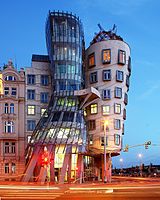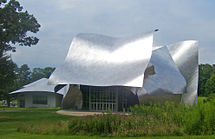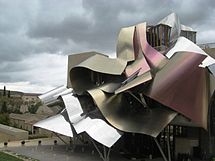Frank Gehry
Frank Owen Gehry CC FAIA (/ˈɡɛəri/; né Goldberg; born February 28, 1929) is a Canadian-born American architect and designer. A number of his buildings, including his private residence in Santa Monica, California, have become world-renowned attractions.
Frank Gehry
- Canada
- United States
Architect
4
Gehry Partners, LLP
His works are considered among the most important of contemporary architecture in the 2010 World Architecture Survey, leading Vanity Fair to call him "the most important architect of our age".[2] He is also the designer of the National Dwight D. Eisenhower Memorial.[3]
Other aspects of career[edit]
Academia[edit]
In January 2011, Gehry joined the University of Southern California (USC) faculty, as the Judge Widney Professor of Architecture.[74] He has since continued in this role at his alma mater. He has also held teaching positions at Harvard University, the University of California at Los Angeles, the University of Toronto, Columbia University, the Federal Institute of Technology in Zürich, and at Yale University, where he still teaches as of 2017.[75]
Though he is often referred to as a "starchitect", he has repeatedly expressed his disdain for the term, insisting he is only an architect.[68][76] Steve Sample, President of the University of Southern California, told Gehry that "...After George Lucas, you are our most prominent graduate".
As of December 2013, Gehry has received over a dozen honorary university degrees (see #Honorary doctorates).
In February 2017, MasterClass announced an online architecture course taught by Gehry that was released that July.[77]
Exhibition design[edit]
Gehry has been involved in exhibition designs at the Los Angeles County Museum of Art dating back to the 1960s. In 1965, Gehry designed the exhibition display for the "Art Treasures of Japan" exhibition at the LACMA. This was followed soon after by the exhibition design for the "Assyrian Reliefs" show in 1966 and the "Billy Al Bengston Retrospective" in 1968. The LACMA then had Gehry design the installation for the "Treasures of Tutankhamen" exhibition in 1978 followed by the "Avant-Garde in Russia 1910–1930" exhibition in 1980. The subsequent year, Gehry designed the exhibition for "Seventeen Artists in the '60s" at the LACMA, followed soon after by the "German Expressionist Sculpture Exhibition" in 1983. In 1991–92, Gehry designed the installation of the landmark exhibition "Degenerate Art: The Fate of the Avant-Garde in Nazi Germany", which opened at the Los Angeles County Museum of Art and traveled to the Art Institute of Chicago, the Smithsonian Institution in Washington, and the Altes Museum in Berlin.[78][79] Gehry was asked to design an exhibition on the work of Alexander Calder at the Los Angeles County Museum of Art's Resnick Pavilion, again invited by the museum's curator Stephanie Barron.[80] The exhibition began on November 24, 2013, and ran through July 27, 2014.
In addition to his long-standing involvement with exhibition design at the LACMA, Gehry has also designed numerous exhibition installations with other institutions. In 1998, "The Art of the Motorcycle" exhibition opened at the Solomon R. Guggenheim Museum with its installation designed by Gehry. This exhibition subsequently traveled to the Field Museum of Natural History in Chicago, the Guggenheim Museum in Bilbao and the Guggenheim Las Vegas.
In 2014, he curated an exhibition of photography by his close friend and businessman Peter Arnell that ran from March 5 through April 1 at Milk Studios Gallery in Los Angeles.[81]
Stage design[edit]
In 1983, Gehry created the stage design for Lucinda Childs' dance Available Light, set to music by John Adams. It premiered at the Museum of Contemporary Art, Los Angeles at the "Temporary Contemporary", and was subsequently seen at the Brooklyn Academy of Music Opera House in New York City and the Theatre de la Ville in Paris. The set consisted of two levels angled in relation to each other, with a chain-link backdrop.[82] The piece was revived in 2015,[83] and was performed, among other places, in Los Angeles and Philadelphia, where it was presented by FringeArts, which commissioned the revival.[84]
In 2012, Gehry designed the set for the Los Angeles Philharmonic's opera production of Don Giovanni, performed at the Walt Disney Concert Hall.
In April 2014, Gehry designed a set for an "exploration of the life and career of Pierre Boulez" by the Chicago Symphony Orchestra, which was performed in November of that year.[85]
Personal life[edit]
In 1954, Gehry changed his surname from Goldberg to Gehry, after his then-wife Anita expressed concern about anti-Semitism.[98]
Having grown up in Canada, Gehry is an avid fan of ice hockey. He began a hockey league, FOG (for Frank Owen Gehry), in his office, though he no longer plays with them.[99] In 2004, he designed the trophy for the World Cup of Hockey.[100] A naturalized U.S. citizen,[101] he also remains a citizen of Canada.[102] He lives in Santa Monica, California, and continues to practice out of Los Angeles.[103]
Gehry is known for his occasional bad temper. During a trip to Oviedo, Spain to accept the Prince of Asturias Award in October 2014, he received a significant amount of attention, both positive and negative, for publicly flipping off a reporter at a press conference who accused him of being a "showy" architect.[104][105]
Gehry is a member of the California Yacht Club in Marina Del Rey, and enjoys sailing with his fiberglass-hulled yacht, Foggy.[106] He also serves on the leadership council of The New York Stem Cell Foundation.[107]
In popular culture[edit]
In 2004, Gehry voiced himself on the children's TV show Arthur, where he helped Arthur and his friends design a new treehouse.[108] He also voiced himself in a 2005 episode of The Simpsons, "The Seven-Beer Snitch", where he designs a concert hall for the fictional city of Springfield. He has since said he regrets the appearance, as it included a joke about his design technique that has led people to misunderstand his architectural process.[109]
In 2006, filmmaker Sydney Pollack made a documentary about Gehry's work, Sketches of Frank Gehry, which followed Gehry over five years and painted a positive portrait of his character; it was well-received critically.[110]
In 2009, architecture-inspired ice cream sandwich company Coolhaus named a cookie and ice cream combination after Gehry. Dubbed the "Frank Behry", it features Strawberries & Cream gelato and snickerdoodle cookies.[111][112]


















